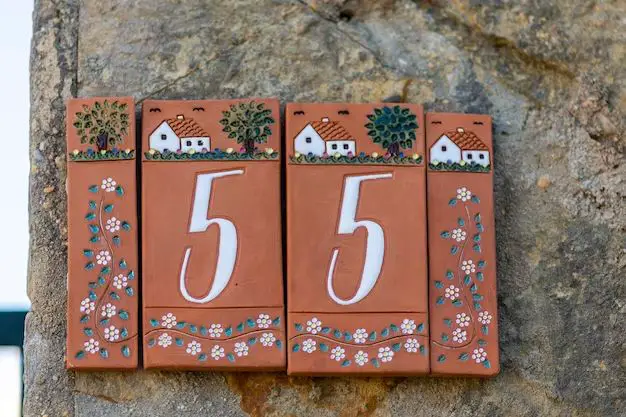When it comes to house numbers, bigger is often better. Large, clearly visible house numbers are important for helping emergency responders, delivery drivers, and visitors find your home quickly and easily. But just how big should modern house numbers be to maximize visibility and meet any legal requirements? Here are some guidelines.
Page Contents
Why Size Matters for House Numbers
There are several important reasons why the size of your house numbers matters:
- Emergency responders need to find your home fast in an emergency. Large numbers can save critical minutes.
- Delivery drivers appreciate big, easy-to-see numbers they can spot from the street.
- Larger numbers are helpful for visitors trying to locate your home.
- Some municipalities have ordinances stipulating the minimum size for house numbers.
When house numbers are too small or hard to read, it can result in delayed emergency response times, missed deliveries, and frustrated visitors circling the block. Investing in properly sized house numbers is a simple way to facilitate prompt service.
Recommended Minimum Size
So what’s the ideal size for modern house numbers? There are a few common recommendations:
- Numbers should be a minimum of 3 inches tall.
- For homes set back further from the street, numbers should be 4-6 inches tall.
- The general rule of thumb is that numbers should be large enough to see from the street at a distance of 50 feet.
These guidelines are based on standard sight lines and visibility. Numbers smaller than 3 inches become difficult to discern at an average distance. And as your home’s setback from the road increases, larger numbers are needed.
Consider Your Home’s Location
When deciding on house number size, also consider your home’s specific location and siting:
- If your house is on a busy road, increase the size to 6 inches or larger.
- Homes at the end of long driveways may need 8-10 inch numbers.
- Rural addresses on winding roads benefit from larger 8-12 inch numbers.
- Corner lots require numbers on both street-facing sides.
The farther your home is set back and the faster traffic moves on your street, the larger your numbers should be for maximum visibility.
Number Material
House number size isn’t the only important factor – you also need numbers made of weather-resistant, reflective material optimized for nighttime visibility:
- Reflective numbers are easiest to see at night when illuminated by headlights.
- Durable metals like aluminum or stainless steel hold up well outdoors.
- Avoid paper, plastic, cardboard or vinyl numbers which deteriorate.
- Change faded numbers that are hard to discern.
Reflective metal address numbers are best for longevity and 24/7 visibility. Plastic and vinyl numbers may save money upfront but don’t last as long.
Number Style
Along with size and materials, the visual style of your house numbers also matters:
- Choose easy-to-read fonts like sans serif, Arial, or Helvetica.
- Avoid overly ornate scripts or faded styles.
- Dark numbers on a light background offer maximum contrast.
- Include hyphens for multi-digit numbers like “127-A”.
Clear, simple numbering looks most legible from the curbside. Skip hard-to-decipher fonts or numbers that blend with your home’s exterior.
Placement Tips
Proper number placement is just as important as size. Some guidelines include:
- Place numbers 4-5 feet off the ground near the main entrance.
- Avoid obstructing landscaping, decorations or fixtures.
- If not at the door, put numbers at the driveway entrance.
- Post numbers on both sides for corner lots and hidden entrances.
Consistent placement at average eye level makes your address easier to spot. Double up numbers where needed so they’re visible from both approach directions.
Legal Requirements
Many municipalities have specific regulations for the posting of house numbers. Some common ordinances include:
- Minimum 3-6 inch number height.
- Reflective, contrasting colors for night visibility.
- Numbers must be clearly visible from the street.
- Multi-residence buildings need unit numbers.
Check your local regulations to ensure your house numbers comply with any mandatory posting rules. Fines may be issued for non-compliant numbers.
Conclusion
When selecting your home’s address numbers, opt for larger-sized options at least 3-4 inches tall. Reflective materials like metal optimize visibility, while simple clean fonts and strategic placement make numbers easy to spot. Adhering to size guidelines and local ordinances ensures your home’s address is clearly identifiable for all who need to find you.
